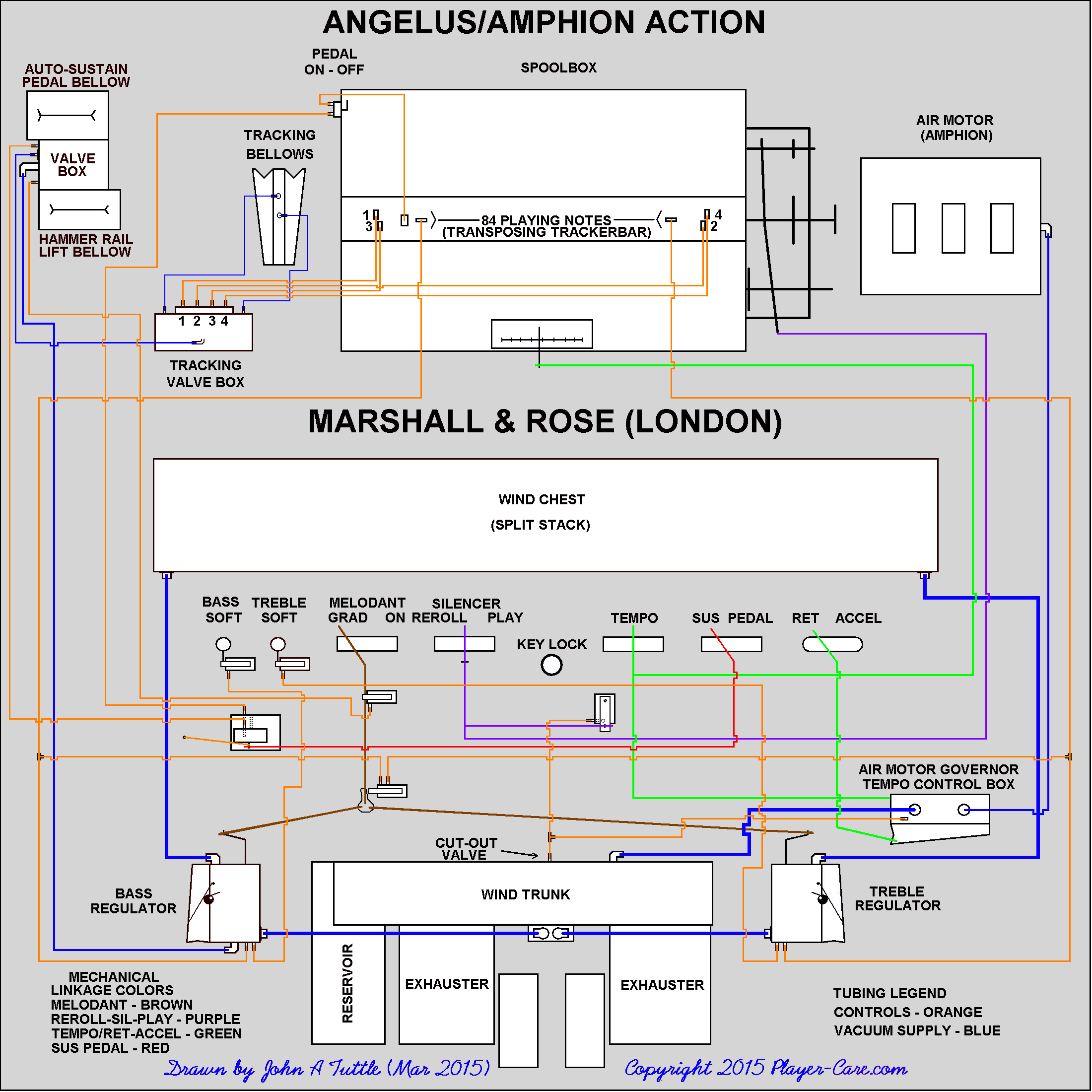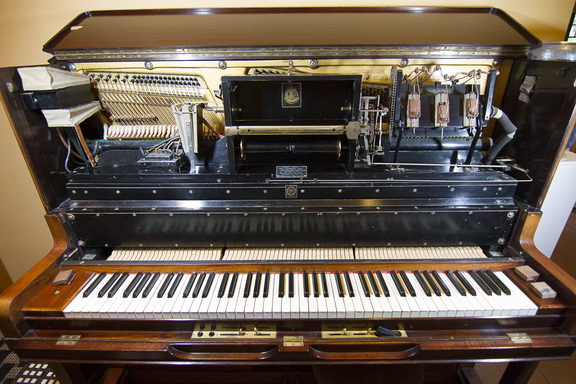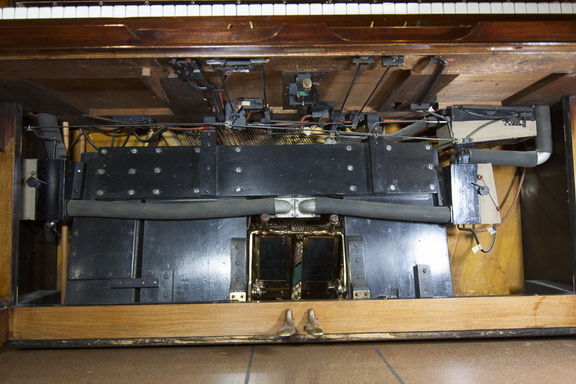
|

|

|

|

|

|
| Home | Manuals | Supplies | Search | Consult | Contact | Testing | Service |



|
At this point, there are a few things that I know for certain. 1. The unit has what's called a 'split stack'. What this means is that the part of the system that senses the note perforations on the music roll is divided into the bass side and the treble side. Most likely there are an equal number of playing notes on each side. 2. The vacuum that is used to power each side of the stack is controlled by an independent vacuum regulator device which is placed between the exhauster assembly (which creates the vacuum by means of the foot pumps) and each side of the stack. 3. These two regulators also appear to contain a cut-off valve which cuts off the vacuum to the stack during the rewind cycle. (I will address more of the particulars of the regulators at a later time.) 4. The action of the cut-off valves is controlled by the movement of the Play/Rewind lever, but I can't quite make out which of the wooden air switches under the keybed are involved. 5. The action of the vacuum regulators is controlled in at least two different manners. One, which is obvious, involves the oversize rectangular holes in the trackerbar. These are typically called 'accent' or 'theme' holes and they operate the regulators automatically as the music is playing by means of turning a valve inside of the regulator 'on' and 'off' at the appropriate time. NOTE: What I cannot see in any of the pictures are the points where the control hoses that operate the stack cut-out valves and the accent valves are connected to the regulators. I'm assuming they are on the back side of the regulators. 6. I'm relatively certain that the action of the regulators can also be controlled manually, but here again I can't see exactly how that is accomplished. There appears to be some linkage that's connected to a wooden valve where there are at least four control hoses. NOTE: What I also need to know is the labeling on all of the controls in front of the keys. I'm almost certain that the pushbuttons are labeled Bass and Treble (left to right). But I'm uncertain about the two levers to the right of the pushbuttons. I'm also rather certain that levers to the right of the center of the piano are labeled Tempo and Play/Rewind (left to right), and the 'rocking' black control (far right) is probably labeled 'Ratard/Accelerando' (or some other trade name). What I cannot see clearly in the pictures is how that control interacts with the system. I get the feeling that it might be a secondary Tempo control, which would allow the user to accelerate or retard the tempo without changing the initial tempo setting as established by the Tempo control lever. If the rocking lever does effect the tempo, it does so mechanically, not pneumatically. A few other obvious characteristics of the system: It has a four-hole tracking device for keeping the holes in the roll aligned with the holes in the trackerbar. This is relatively common. It has an automatic sustain device which is triggered by the square hole on the left side of the trackerbar between the two offset tracking holes and the rectangular theme (or accent) hole. Also, there will be a hose from the auto-sustain hole in the trackerbar that's connected to one side of the metal switch that's mounted in the upper half of the spoolbox on the left side wall. That switch is probably labeled 'Loud' or 'Sustain'. It is an 'On/Off' switch and the other hose that's connected to the switch will go to the valve on the auto-sustain device -which the the larger of the two bellows mounted on the left side wall of the piano in the upper half of the piano. The bellows underneath the sustain bellows is the Bass Soft bellow. The Treble Soft bellows is located in the same position on the right side wall. These bellows are most likely triggered into operation manually by the two pushbuttons in front of the keys. The air motor governor/tempo control box is highly sophisticated as evidenced by what appears to be eight or nine adjusters that are used for calibrating the linearity of the device. It also employs a rather unique way of adjusting the governor spring tension -which is used to automatically compensate for the changing vacuum levels within the system as the user pumps the pedals faster or slower to change the expression of the music. (This is a whole other topic.) The pumper assembly (or Exhauster Assembly) is quite generic, having two large exhauster bellows and one smaller reservoir bellows (that stores the vacuum created by the exhausters). The air motor, as I stated previously, was made by Amphion. Their 6-chamber motor is well known for both its power and its smoothness. Unlike the common 5-chamber motor, which has a 72 degree duty cycle, the 6-chamber motor has a 60 degree duty cycle. The unit is equipped with a "transposing trackerbar", which allows the user to change the key of the music two notes either side of normal or 'zero'. However, I can't make out from the pictures exactly how the user is suppose to move the position of the adjuster. (That's the fairly large brass piece with the markings on the front that's located at the right end of the trackerbar.) It's also important to note that anytime you have a transposing trackerbar, you also have rubber tubing connected to the trackerbar which flexes as the bar is move right or left of center. Most often, this tubing has become brittle and cracked, or it will be so hard that the bar cannot be moved. The transmission is fairly straightforward, having both forward roll and rewind brakes. It's a little difficult to tell (from the pictures) how the rewind brake gets engaged by the movement of the Play/Rewind lever... Also, I can't see how either of the brakes would be adjusted for the proper tension without bending metal pieces. (Normally there would be some relatively easy way to adjust the brake tension.) I think that about covers the basics. What I need are closeup pictures of all of the components that are mounted under the keybed. These should be taken at about one to two feet from the subject and each subject should be shot from two different angles. You should start at either the left or right end and shot the pictures progressively from one side to the other. Imagine, if you will, that I'm sticking my head inside the piano and looking closely to determine how each of the components is connected to another component. So, if a piece of linkage or a rubber tube goes from point A to piano B, I have to be able to see that in a series of pictures. Eventually, I'll draw a diagram, or a sort of roadmap, of what each of the levers or buttons control. Lastly, it should go without saying that most, if not all of this data will be used in the creation of a treatise about the player action.

For The Accuracy or Validity of the Statements and/or Opinions Expressed within the Pages of the Player-Care Domain. Cartoon Graphics by E7 Style Graphics (Eric Styles)

|